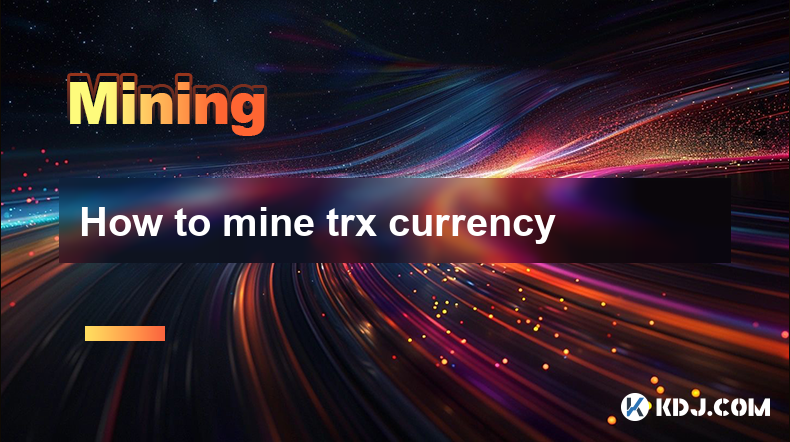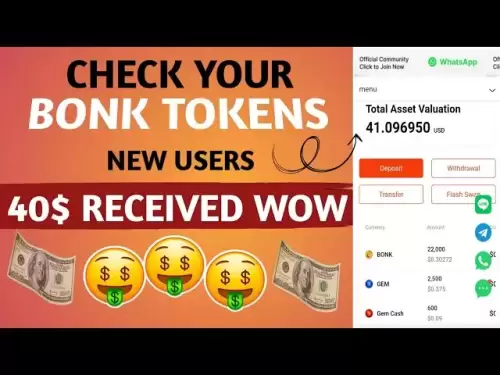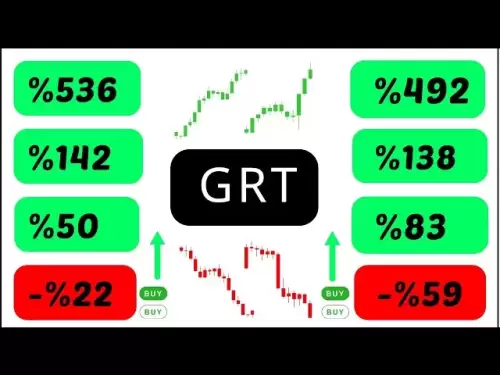-
 Bitcoin
Bitcoin $107,896.0459
2.21% -
 Ethereum
Ethereum $2,435.2616
0.04% -
 Tether USDt
Tether USDt $1.0004
-0.01% -
 XRP
XRP $2.2018
-0.04% -
 BNB
BNB $647.5191
0.76% -
 Solana
Solana $144.4128
0.58% -
 USDC
USDC $0.9999
-0.01% -
 TRON
TRON $0.2730
-0.32% -
 Dogecoin
Dogecoin $0.1660
1.16% -
 Cardano
Cardano $0.5723
-1.81% -
 Hyperliquid
Hyperliquid $37.4395
-0.04% -
 Bitcoin Cash
Bitcoin Cash $485.2395
7.09% -
 Sui
Sui $2.7770
0.33% -
 Chainlink
Chainlink $13.2388
-0.84% -
 UNUS SED LEO
UNUS SED LEO $9.0047
-0.11% -
 Stellar
Stellar $0.2431
-1.84% -
 Avalanche
Avalanche $17.7557
-1.65% -
 Toncoin
Toncoin $2.8566
-1.08% -
 Shiba Inu
Shiba Inu $0.0...01168
0.88% -
 Litecoin
Litecoin $84.9442
0.32% -
 Hedera
Hedera $0.1513
-1.26% -
 Monero
Monero $315.0784
-0.32% -
 Ethena USDe
Ethena USDe $1.0001
-0.04% -
 Polkadot
Polkadot $3.4120
-0.77% -
 Dai
Dai $0.9999
0.00% -
 Bitget Token
Bitget Token $4.3352
1.20% -
 Pi
Pi $0.6312
17.49% -
 Uniswap
Uniswap $6.9875
-0.83% -
 Pepe
Pepe $0.0...09694
-1.76% -
 Aave
Aave $259.5059
-1.43%
How to mine trx currency
By understanding TRX staking and choosing a suitable staking platform, individuals can participate in the TRON network and earn rewards for contributing to its security and stability.
Jan 10, 2025 at 08:30 pm

How to Mine TRX Currency: A Step-by-Step Guide
Key Points:
- TRON (TRX) is a decentralized blockchain platform designed for entertainment content distribution.
- TRX is the native cryptocurrency of the TRON network and can be mined using a process known as staking.
- Staking involves holding TRX tokens in a designated wallet and participating in the network's consensus mechanism.
- Staking rewards are distributed based on the amount of TRX staked and the duration of staking.
- There are multiple methods to stake TRX, including using a software wallet, hardware wallet, or participating in a mining pool.
Step 1: Understand TRX Staking
TRX staking is the process of holding TRX tokens in a staking wallet to participate in the network's consensus mechanism. Stakers receive rewards for contributing to the network's security and stability. The staking rewards are calculated based on the number of TRX tokens staked and the length of time they are staked for.
Step 2: Choose a TRX Staking Method
There are several ways to stake TRX, including using a software wallet, hardware wallet, or participating in a mining pool.
- Software wallet: A software wallet is a digital wallet that can be installed on a desktop computer, laptop, or mobile device. Software wallets are convenient and easy to use, but they are also more susceptible to hacking and security breaches.
- Hardware wallet: A hardware wallet is a physical device that stores TRX tokens offline. Hardware wallets are more secure than software wallets, but they are also more expensive.
- Mining pool: A mining pool is a group of miners that combine their computing resources to mine TRX. Mining pools offer a more consistent and reliable way to earn staking rewards, but they also come with a higher risk.
Step 3: Choose a Staking Platform
There are several staking platforms available, including TronWallet, Binance, and Huobi Global. Each platform offers different features and fees, so it is important to compare them before choosing one.
Step 4: Stake Your TRX
Once you have chosen a staking platform, you can stake your TRX by sending them to the staking address provided by the platform. The staking address is usually a unique identifier that is generated for each individual staker.
Step 5: Monitor Your Staking Progress
Once you have staked your TRX, you can monitor your progress by logging into your staking platform account. The platform will provide you with information about your staking rewards, the current value of your TRX, and the remaining duration of your staking period.
Step 6: Unstake Your TRX
When you are ready to unstake your TRX, you can do so by logging into your staking platform account and sending your TRX to a destination address. The unstaking process can take several hours or even days, depending on the platform you are using.
Step 7: Calculate Your Staking Rewards
Your staking rewards will be calculated based on the amount of TRX staked, the duration of staking, and the staking platform you are using. The staking rewards are typically paid out on a daily or weekly basis.
FAQs on TRX Staking
What is the minimum amount of TRX I need to stake?
There is no minimum amount of TRX required to stake. However, most staking platforms require a minimum amount of TRX in order to be eligible for staking rewards.
How long do I need to stake my TRX for?
The duration of staking can vary depending on the platform you are using. Some platforms offer flexible staking, which allows you to stake your TRX for any length of time. Other platforms offer fixed-term staking, which requires you to stake your TRX for a specific period of time.
What are the risks of TRX staking?
There are a few risks associated with TRX staking, including:
- Loss of funds: If you stake your TRX on a fraudulent or unreliable platform, you may lose your funds.
- Market volatility: The price of TRX can fluctuate, which can affect the value of your staking rewards.
- Technical issues: The staking platform you are using may experience technical issues, which can delay or disrupt your staking rewards.
Disclaimer:info@kdj.com
The information provided is not trading advice. kdj.com does not assume any responsibility for any investments made based on the information provided in this article. Cryptocurrencies are highly volatile and it is highly recommended that you invest with caution after thorough research!
If you believe that the content used on this website infringes your copyright, please contact us immediately (info@kdj.com) and we will delete it promptly.
- Ethereum, ZK-Powered Bridges, and Cross-Chain Liquidity: A New Era?
- 2025-06-26 02:45:13
- Ruvi AI: The Breakout Star That Could Outshine Tron in 2025?
- 2025-06-26 02:45:13
- XRP Whales: Accumulation vs. Stalled Momentum - What's the Deal?
- 2025-06-26 02:50:12
- Moca Chain: The Layer 1 Blockchain Revolutionizing Digital Identity
- 2025-06-26 02:27:14
- Mega Matrix, Bitcoin, and Treasury Strategy: A New Era of Corporate Finance
- 2025-06-26 02:55:12
- SBI's QIP Issue: A Token of Prestige for Lead Arrangers
- 2025-06-26 02:31:57
Related knowledge

What is liquidity mining in DeFi? How to participate and calculate the income?
Jun 20,2025 at 03:21pm
Understanding Liquidity Mining in DeFiLiquidity mining is a core concept in the decentralized finance (DeFi) ecosystem that allows users to earn rewards by providing liquidity to decentralized exchanges (DEXs) or lending platforms. In traditional finance, liquidity providers are usually institutional players, but DeFi democratizes this process, enabling...

What is the mining mechanism of digital currency? What hardware and cost investment are required?
Jun 23,2025 at 06:29am
Understanding the Mining Mechanism of Digital CurrencyThe mining mechanism of digital currency is a foundational process that ensures transaction validation and network security. In most Proof-of-Work (PoW) cryptocurrencies like Bitcoin, miners compete to solve complex mathematical puzzles using computational power. The first miner to find a valid solut...

Analysis of hybrid mining protocol: PoW+PoS hybrid profit calculation
Jun 23,2025 at 10:15am
Understanding Hybrid Mining ProtocolsIn the realm of blockchain technology, consensus mechanisms are pivotal in maintaining network integrity and transaction validation. A hybrid mining protocol combines two or more consensus algorithms to achieve a balance between security, decentralization, and energy efficiency. The most commonly adopted hybrid model...

How to operate option mining? Hedging strategy and profit structure
Jun 21,2025 at 03:29pm
What is Option Mining?Option mining refers to a decentralized finance (DeFi) strategy where participants provide liquidity or take specific derivative positions in options protocols to earn rewards. Unlike traditional yield farming, option mining often involves liquidity provision for options markets, allowing users to generate returns through premiums ...

What are the advantages of Layer2 mining? Gas saving and project inventory
Jun 20,2025 at 04:50am
Understanding Layer2 Mining and Its SignificanceLayer2 mining refers to the process of participating in decentralized applications or protocols that operate on top of a primary blockchain (such as Ethereum) using scaling solutions like Optimism, Arbitrum, or zkSync. Unlike traditional mining on Layer1 blockchains, which often involves high computational...

Is contract mining safe? Key points of smart auditing and vulnerability prevention
Jun 19,2025 at 08:08pm
Understanding Contract Mining in the Cryptocurrency SpaceContract mining refers to a method within blockchain ecosystems where users can participate in mining operations through smart contracts. Unlike traditional mining, which requires physical hardware and technical expertise, contract mining allows participants to invest funds into a mining pool or p...

What is liquidity mining in DeFi? How to participate and calculate the income?
Jun 20,2025 at 03:21pm
Understanding Liquidity Mining in DeFiLiquidity mining is a core concept in the decentralized finance (DeFi) ecosystem that allows users to earn rewards by providing liquidity to decentralized exchanges (DEXs) or lending platforms. In traditional finance, liquidity providers are usually institutional players, but DeFi democratizes this process, enabling...

What is the mining mechanism of digital currency? What hardware and cost investment are required?
Jun 23,2025 at 06:29am
Understanding the Mining Mechanism of Digital CurrencyThe mining mechanism of digital currency is a foundational process that ensures transaction validation and network security. In most Proof-of-Work (PoW) cryptocurrencies like Bitcoin, miners compete to solve complex mathematical puzzles using computational power. The first miner to find a valid solut...

Analysis of hybrid mining protocol: PoW+PoS hybrid profit calculation
Jun 23,2025 at 10:15am
Understanding Hybrid Mining ProtocolsIn the realm of blockchain technology, consensus mechanisms are pivotal in maintaining network integrity and transaction validation. A hybrid mining protocol combines two or more consensus algorithms to achieve a balance between security, decentralization, and energy efficiency. The most commonly adopted hybrid model...

How to operate option mining? Hedging strategy and profit structure
Jun 21,2025 at 03:29pm
What is Option Mining?Option mining refers to a decentralized finance (DeFi) strategy where participants provide liquidity or take specific derivative positions in options protocols to earn rewards. Unlike traditional yield farming, option mining often involves liquidity provision for options markets, allowing users to generate returns through premiums ...

What are the advantages of Layer2 mining? Gas saving and project inventory
Jun 20,2025 at 04:50am
Understanding Layer2 Mining and Its SignificanceLayer2 mining refers to the process of participating in decentralized applications or protocols that operate on top of a primary blockchain (such as Ethereum) using scaling solutions like Optimism, Arbitrum, or zkSync. Unlike traditional mining on Layer1 blockchains, which often involves high computational...

Is contract mining safe? Key points of smart auditing and vulnerability prevention
Jun 19,2025 at 08:08pm
Understanding Contract Mining in the Cryptocurrency SpaceContract mining refers to a method within blockchain ecosystems where users can participate in mining operations through smart contracts. Unlike traditional mining, which requires physical hardware and technical expertise, contract mining allows participants to invest funds into a mining pool or p...
See all articles























































































